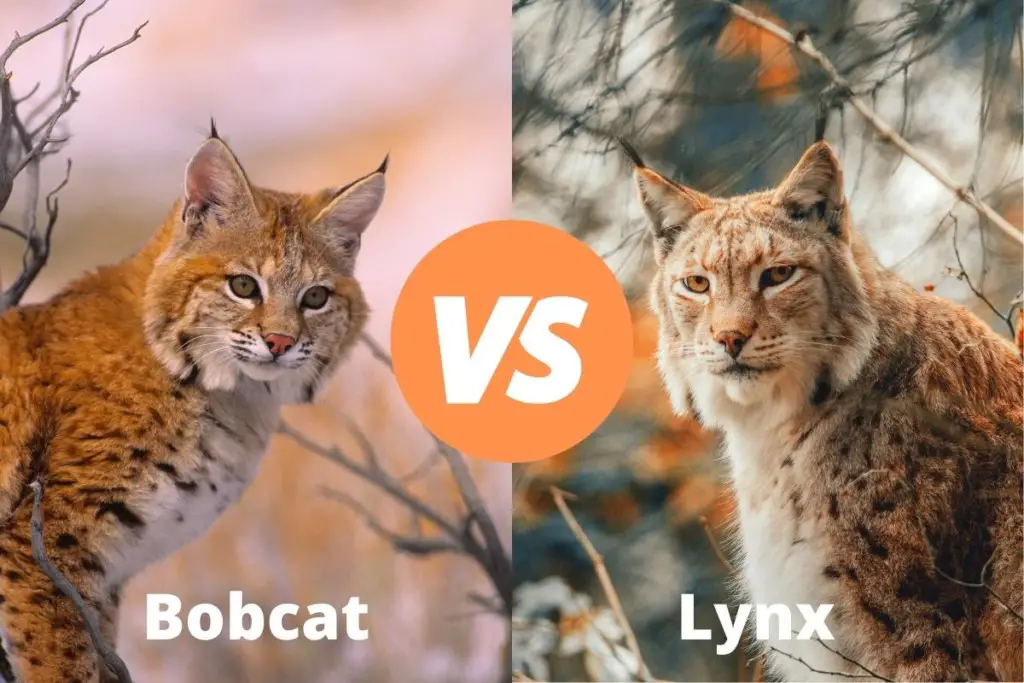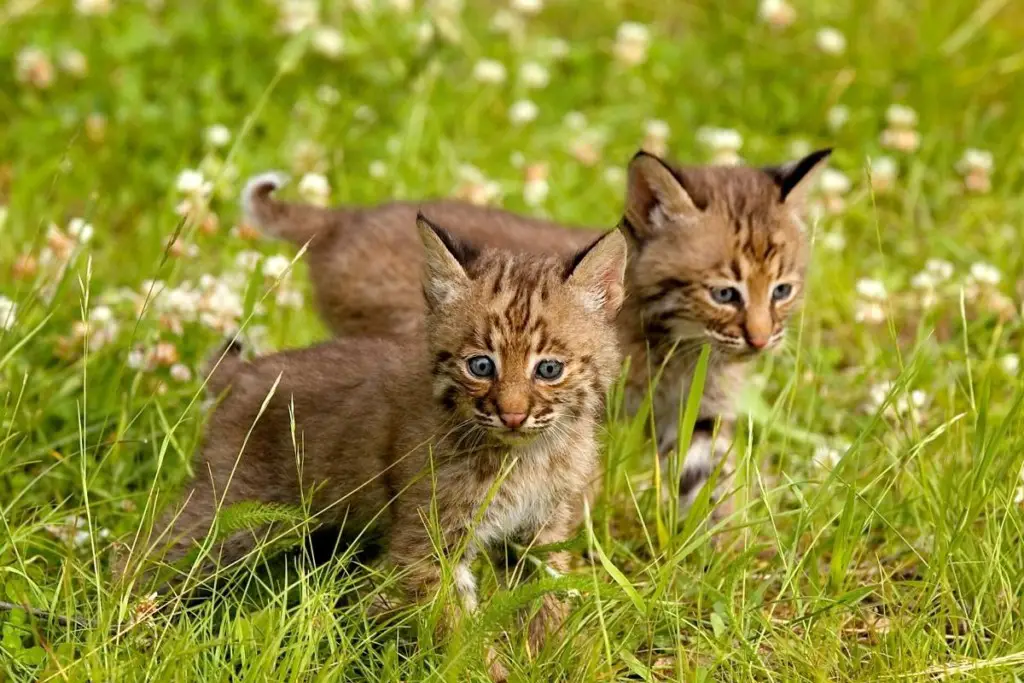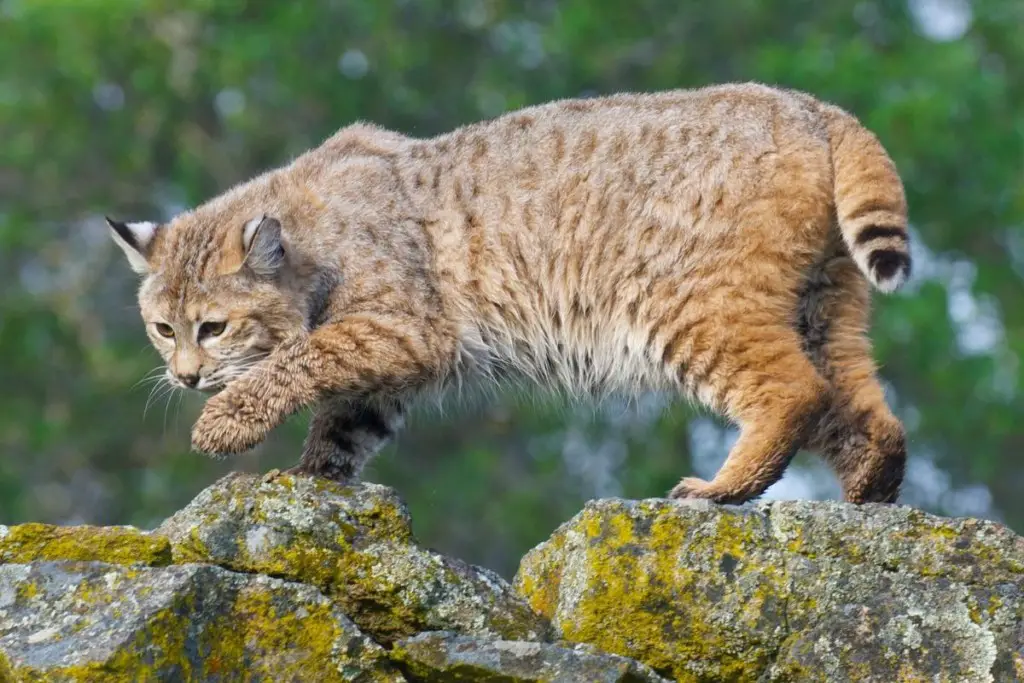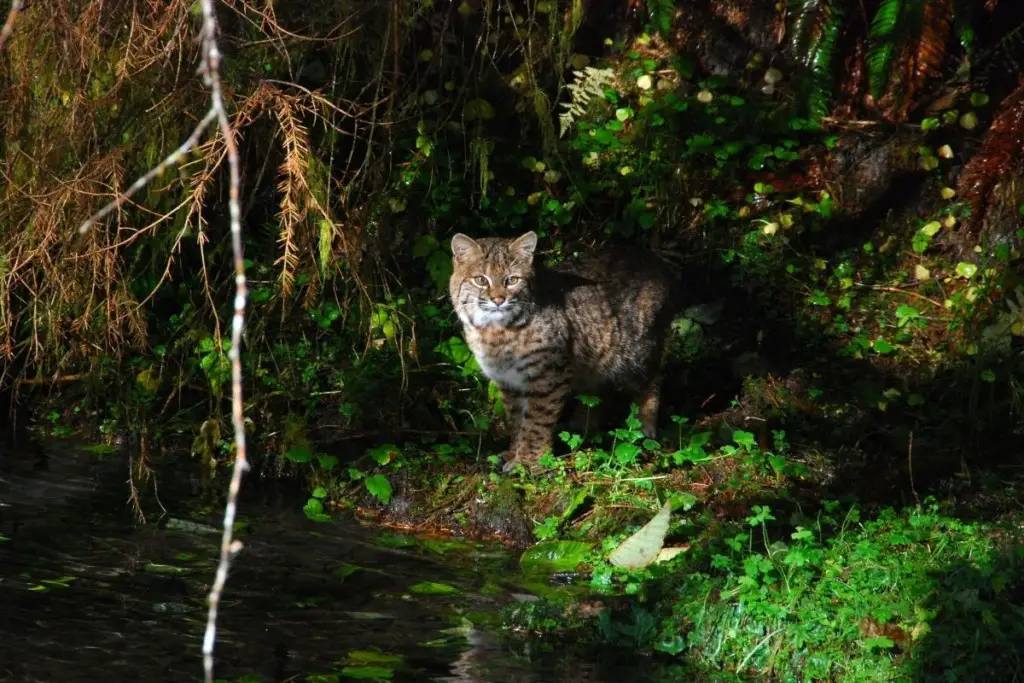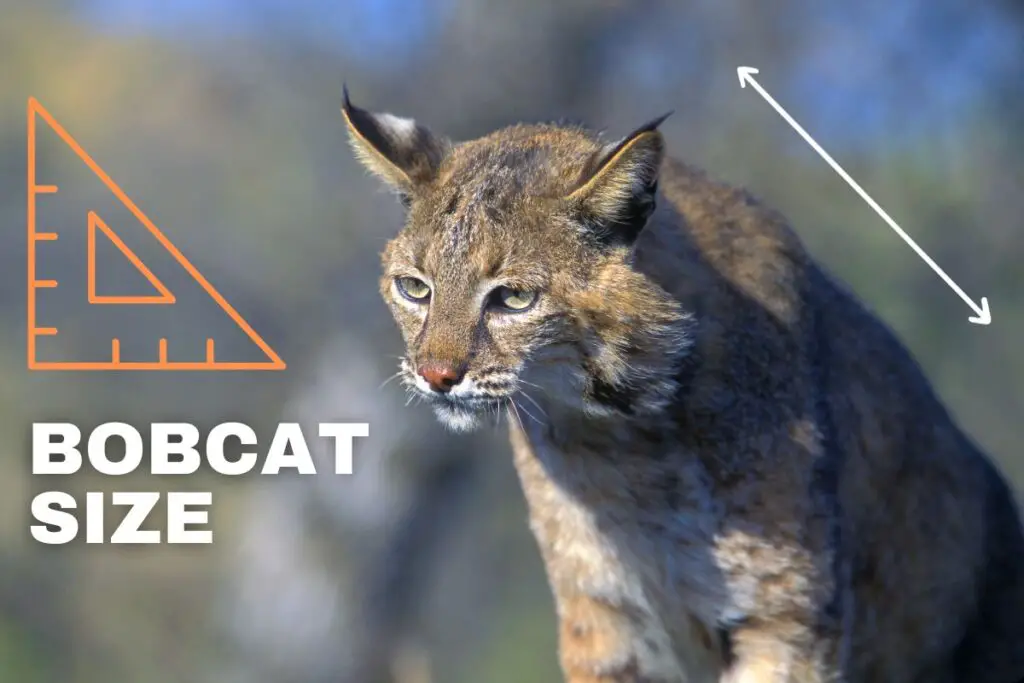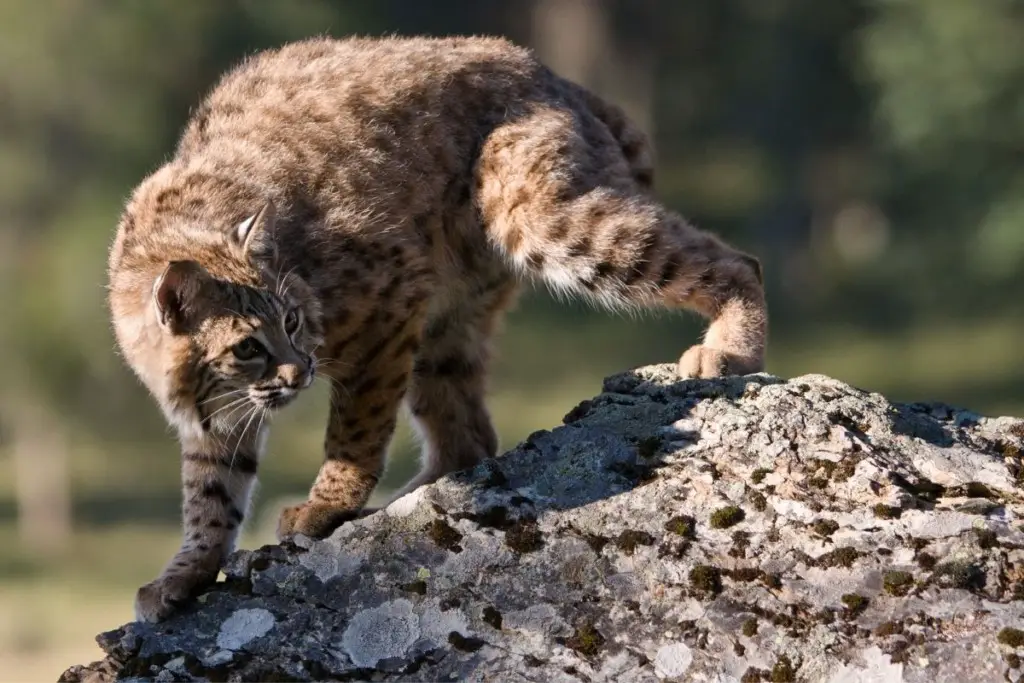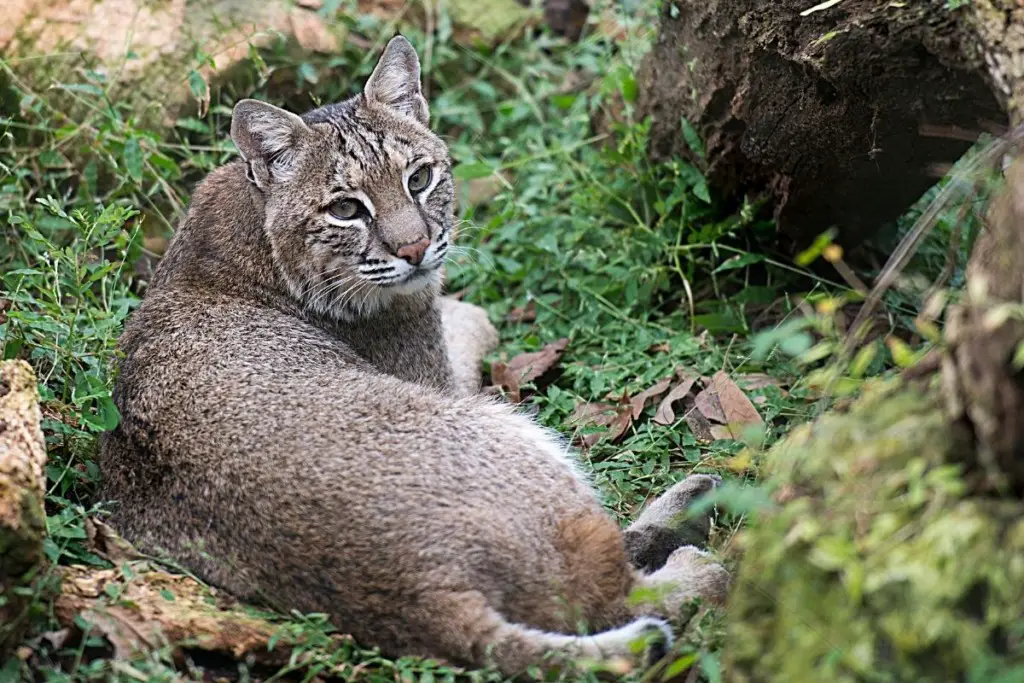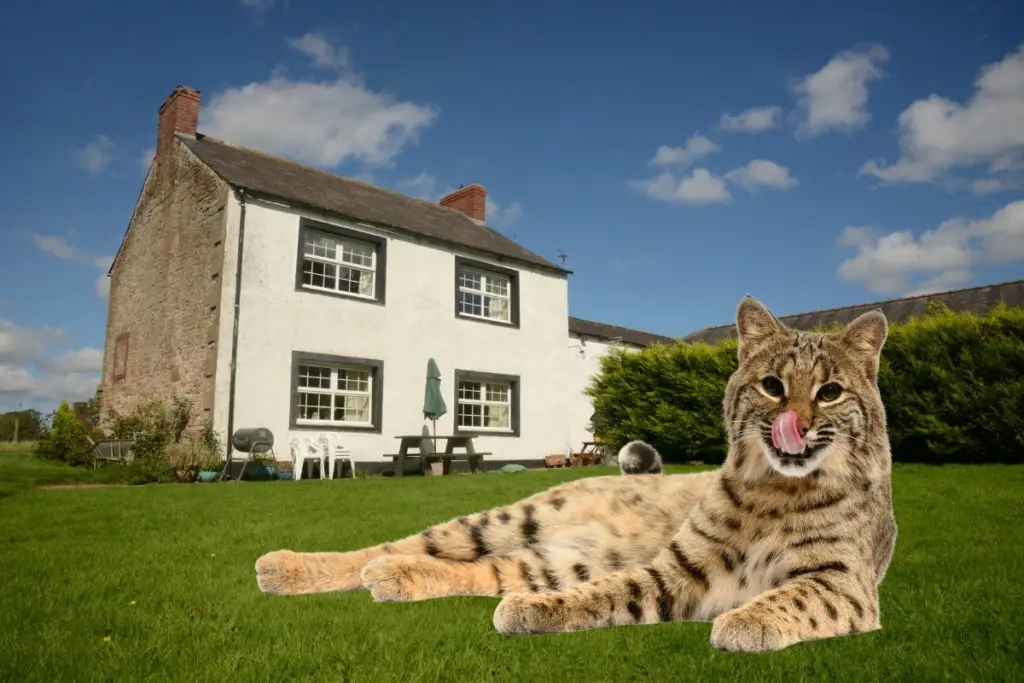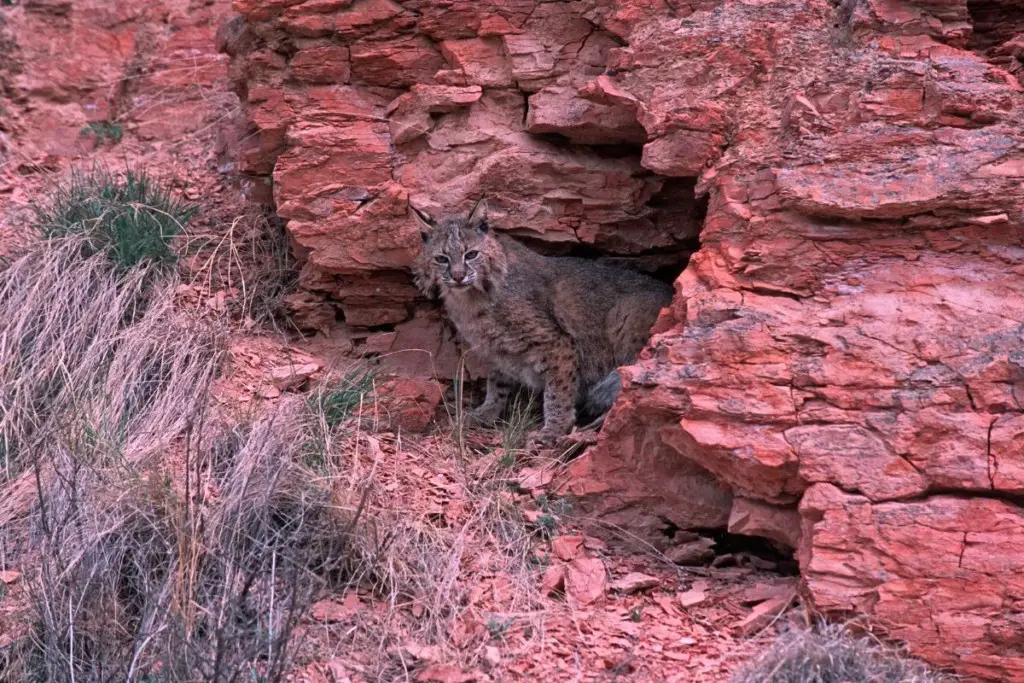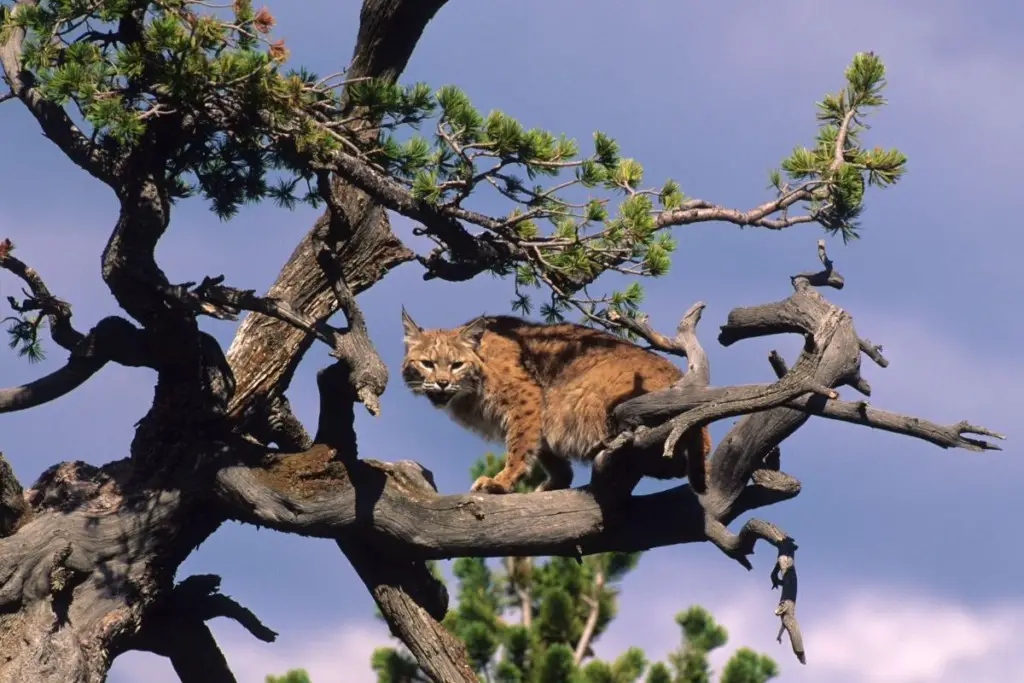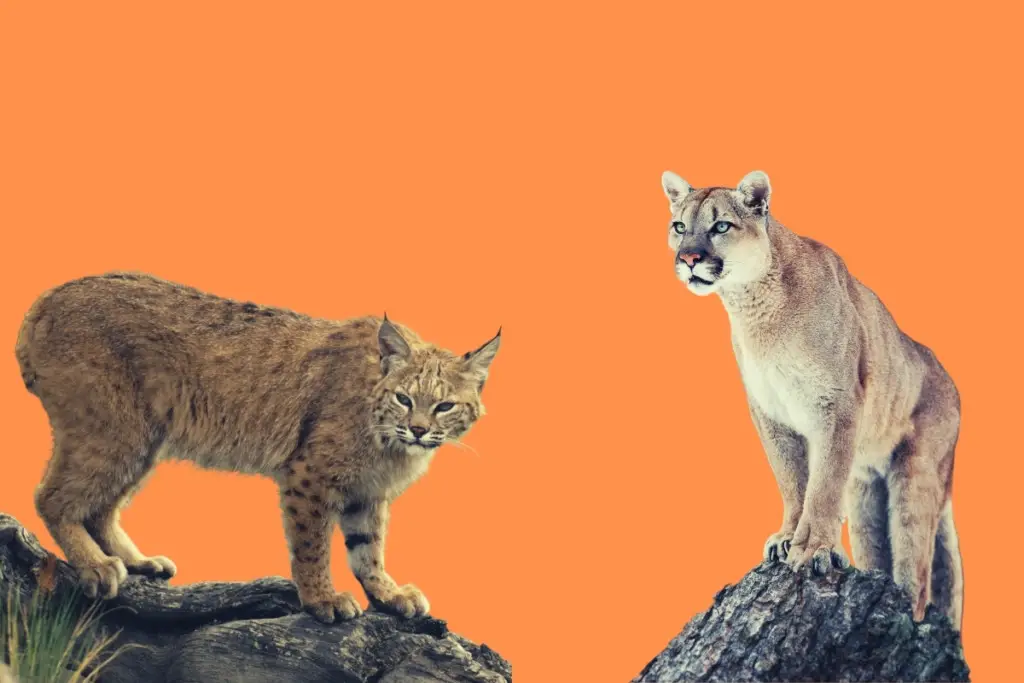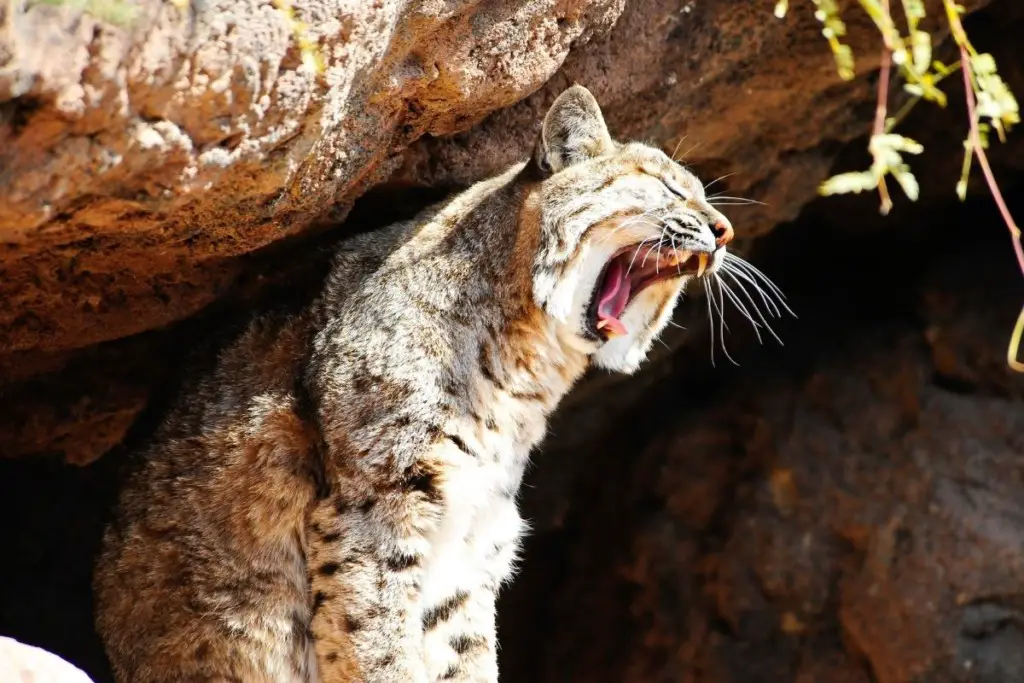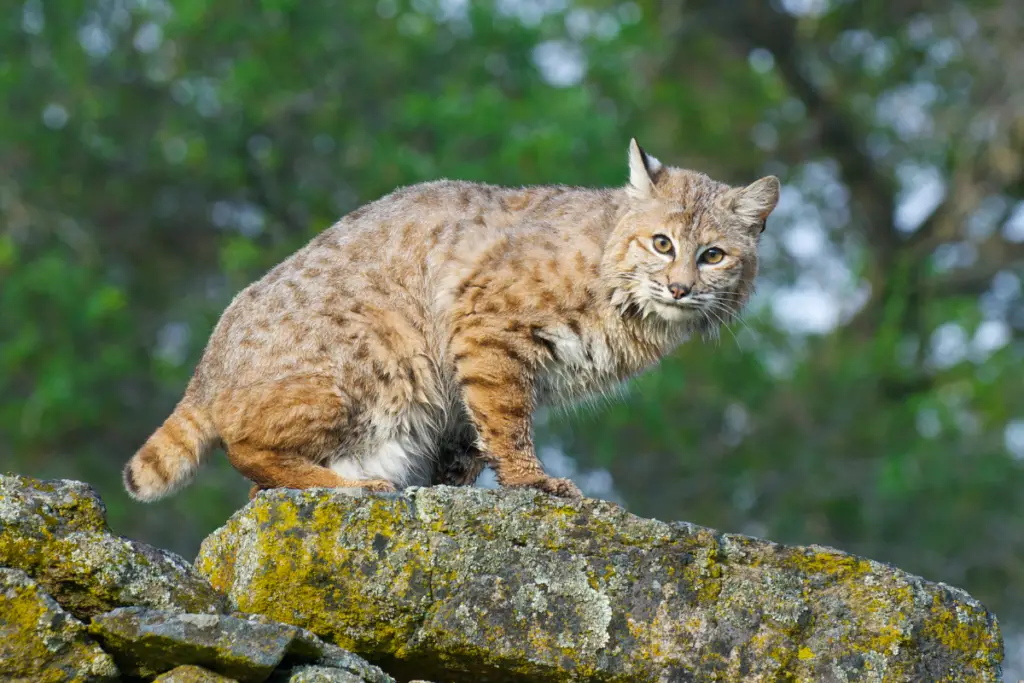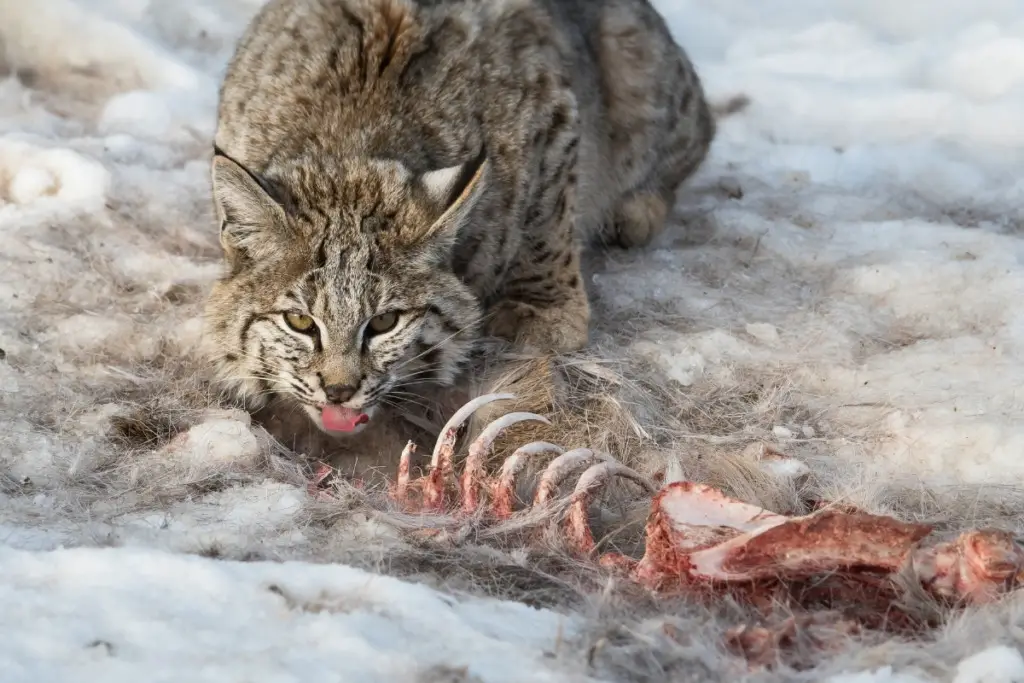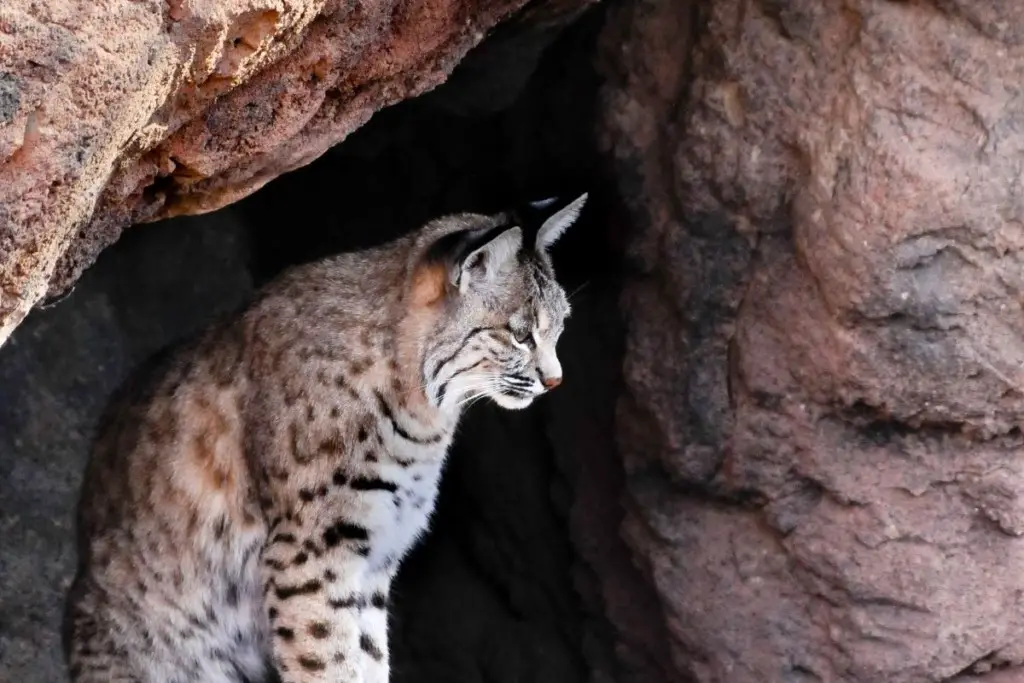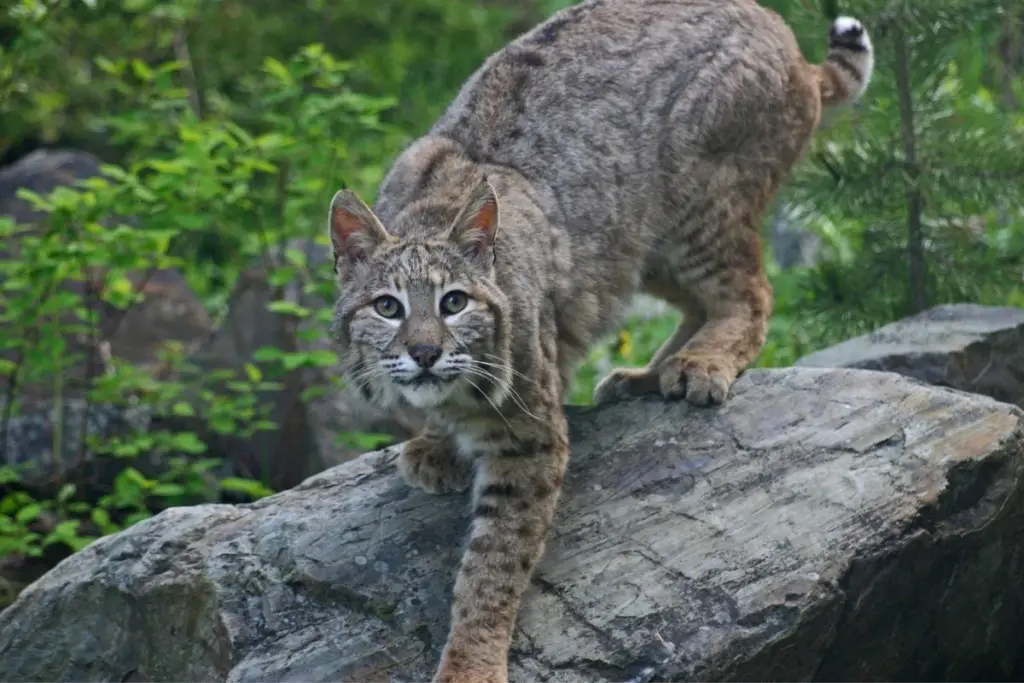I’ve spent many hours observing and studying bobcats. In the past few years, I’ve learned a lot about America’s wild cats.
So I thought, let’s share what I’ve learned with the rest of the world!
Bobcats are one of the smallest, large cats, within the Lynx genus. They occupy many parts of the United States, Canada, and Mexico. Bobcats are extremely adaptable and thrive in many regions. Let’s Learn a little more about bobcats and how they got their name!
The bobcat is a large cat that lives in North America. They get their name from their noticeably short, bobtails. Big cat species can be traced back millions of years, and bobcats are part of that evolutionary lineage. They hunt mostly in open areas, such as fields, forest meadows, and other areas where they can see their prey out in the open, from a vantage point.
The bobcat’s history in America can be traced back thousands of years. Historians believe that they have found a mound, in which a bobcat was ceremonially buried by native peoples who lived in the modern area of western Illinois. Evidence shows that, back then, Native Americans had already attempted to tame these wild cats. Source.
| Bobcat Scientific Classification | |
| Kingdom: Animalia | Phylum: Chordata |
| Class: Mammalia | Order: Carnivora |
| Suborder: Feliformia | Family: Felidae |
| Subfamily: Felinae | Genus: Lynx |
| Species: Lynx rufus |
See our article for Bobcat Species
Bobcats are medium-sized, big cats. Even though they are not as big as other large cats such as cougars, they can still be a fierce force in the wild.
Learn more about Bobcat Size
Now that you know a little bit about the history of bobcats, let’s take a closer look at the animal, their behavior, and more.
Bobcat Tracks
Bobcat tracks are 2 inches in length and 2 inches in width, with their front feet being larger than their hind feet. They look just a little larger than a domestic cat’s footprints. Bobcats have four digits on each foot. You do not see their claws in their tracks because cats have retractable claws and they very rarely show an indentation.
When it comes to the animals that live in certain areas, tracks can be one of the best ways to identify them. The tracks will tell you a story of what type of animals are lurking around at night when no one else is there to see. Whether it is in the wild, or on your own property, being able to identify what animals are present can be a very valuable skill.
Hunters and trappers use animal tracks, as well as scat, to track what animals are in their territory. In the past, humans relied on these tracking skills for survival, today we still use these techniques to provide us with information.
What Do Footprints of a Bobcat Look Like?
A bobcat’s foot has four long slightly pointy digits. They do not leave claw marks on the ground, because their claws are retractable. Besides the four footpads, they have a large carpel pad. A bobcat’s prints are smaller than the print of a Canadian Lynx or a mountain lion.
See our article for Bobcat vs Lynx
What Does a Bobcat Track in the Snow Look Like?
In the snow, a bobcat’s track is going to have four digits and a large carpel pad pressed into the snow. If the snow is deep and loosely packed, you may only see footholes punched into the snow, with little variation in the toes.
Bobcats, and cats in general, have a method of walking called direct registering. This means their back feet fall into the footprints of their front paws. This is sometimes known as diagonal walking. You will be able to notice this pattern in the dirt and mud as well as in the snow.
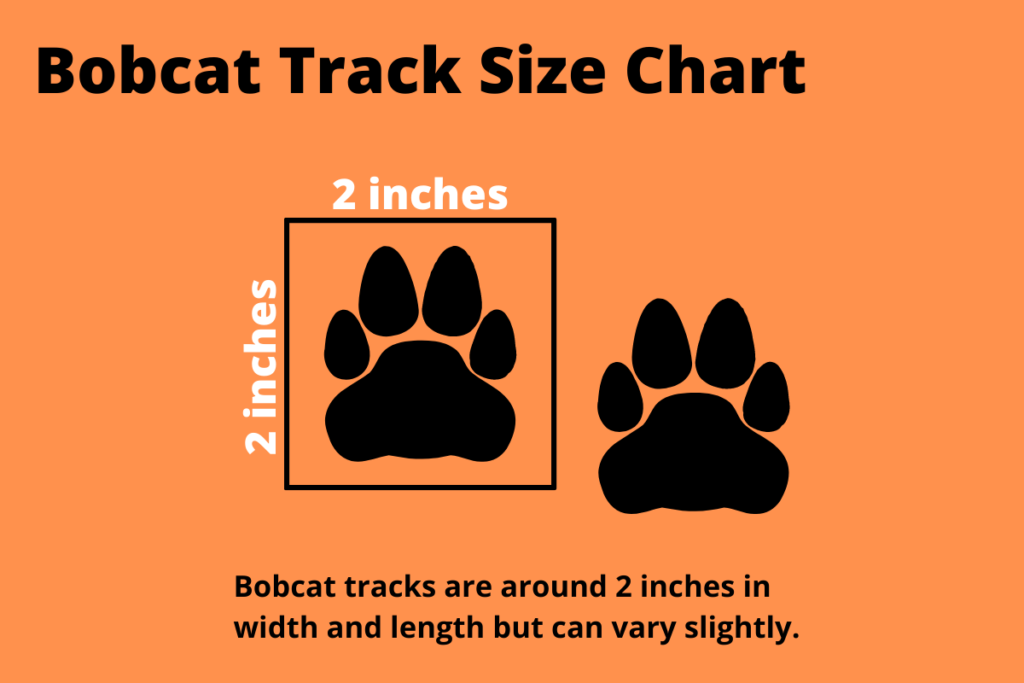
Bobcat Poop
Bobcat poop is 4 inches long and ¾ of an inch thick. The scat is segmented into links. The ends of bobcat poop are slightly rounded and are sometimes pointy. The scat is usually solid segments, containing some hair and fibers from their prey.
As we have mentioned, tracking an animal can be done in many ways. Besides animal tracks, one of the easiest ways to know if you have a bobcat living near you is by analyzing the scat in your area. Bobcat poop can be easy to identify, by the shape, size, and contents of the poo.
Looking at bobcat poop may not sound like such a fun thing to do. However, the contents can tell you a lot about the animal, what they are eating, and how close they are to where you live. You may also be able to see if something is wrong with an animal if you find things like worms or parasites.
See our article for How Long Do Bobcats Live
What Does Bobcat Poop Look Like?
Bobcat poop is brown, dark brown, or black. When bobcat poop is wet it will be a slick brown or dark brown color. Dry bobcat poop is a darker brown and sometimes black. Wet bobcat poop can be a sign that one could be currently in your area.
Animals like bobcats usually have an area where they do their business, these areas are called latrines. If you come upon a latrine area, you are going to be very close to the bobcat den. In this area, you will find scat, and you will smell bobcat urine.
See our article for Bobcat Dens
What Does Bobcat Poop Smell Like?
Bobcats eat mostly an all-meat diet. Their poop smells much like the poop of other carnivorous animals. You may also be able to find the smell of bobcat urine around the same area. Bobcat urine has a potent smell that smells a lot like concentrated housecat urine.
Bobcat Ears
Bobcats are part of the Lynx family, and their ears are one of the most noticeable traits that they have. That is, besides their bobbed-looking tail. Felines are known for having excellent hearing. This is especially useful for wild cats, who count on their senses and instincts for survival.
Learn more about Bobcat Tails
Even though they have a similar hearing range as humans, they can hear high-pitched noises better. They can also hear high-pitched noises better than canines, such as dogs and foxes.
Do Bobcats Have Tufts on Their Ears?
Bobcats have very large ears that are pointed with small tufts of hair on the tips. Bobcat ears can be used as a way to identify whether or not the wild cat is a bobcat. It can help tell if it is a bobcat, a Canadian Lynx, or a different kind of cat, like a cougar/mountain lion (that usually does not have the tuft.) The tuft on a bobcat’s ears is usually shorter, and not as pronounced as its other Linx relatives. Mountain lions do not have tufts.
What Do Bobcat Ears Look Like?
Besides the tuft, bobcat ears look a lot like domestic cat ears from the front. From the back, however, bobcat ears have a pattern that looks like white eyes against dark fur. This is called an ocellus (eyespot) and many other cats such as tigers have this interesting spotting. Its also been speculated that bobcat kittens can see the white eyes from the back of their mother’s ears at night, to better follow them.
Their ears are usually a mix of colors including black, white, orange, and yellow. The tuft is black on a bobcat, although, sometimes it may not be quite as pronounced on some bobcats.
Their ears, like other felines, also have little pockets on them called Henry’s pockets. These little pouch-shaped pockets are thought to have several different uses, such as being able to better hear high-pitched sounds, especially with kittens.
See our article for What Do Bobcats Look Like

What Eats Bobcats
When most people think of bobcats, they consider them apex predators. This is true to a degree. They are near the top of the food chain. However, in areas where their territory overlaps with other apex predators such as wolves, mountain lions, and other larger animals, they can become the prey.
Bobcat Predators
Bobcats can be eaten by predators such as mountain lions, wolves, coyotes, eagles, bears, fishers, and humans. Bobcat kittens are the most at risk of predation. Most large animals would not pick a fight with a bobcat because of the bobcat’s ability to fight back.
Other Large Cats
Some bobcats live in areas where their territory may overlap with other large cats such as mountain lions, and the Canadian Lynx. If their paths cross, this could result in a fight over territory. In many cases like this, the victor will eat the fallen cat. Some might consider this behavior strange since they are related to other cats but in the wild animals do what they must to survive.
See our article for Bobcat vs Mountain Lion
Canid Predators
Wild canids sometimes live in territories that overlap with bobcats. A fight between a wolf, or another type of large canid, would most likely result in the bobcat becoming the loser. Wild canids are usually twice as large as a bobcat. Wolves, coyotes, and bobcats are all territorial animals that would fight to the death over territory.
Eagles
Some types of eagles may be large enough to snatch up a small bobcat, or bobcat kitten. However, this would be a rare encounter. Bobcats are very protective and they would not put their young in a situation where they would be in danger if they could avoid it.
Other Bobcat Predators
There are a few other predators such as fishers, bears, and even humans. If a bobcat were to cross the path of a bear or a fisher it may end in a fight over territory, or the bobcat could become food for a bear.
Humans are probably the bobcat’s biggest threat. While most people do not eat bobcats, (believe it or not, some people do) they still hunt them and trap them. Unfortunately, many that are hunted become trophies, and the ones who are trapped are sold to the fur trade or into the exotic cat trade industry.
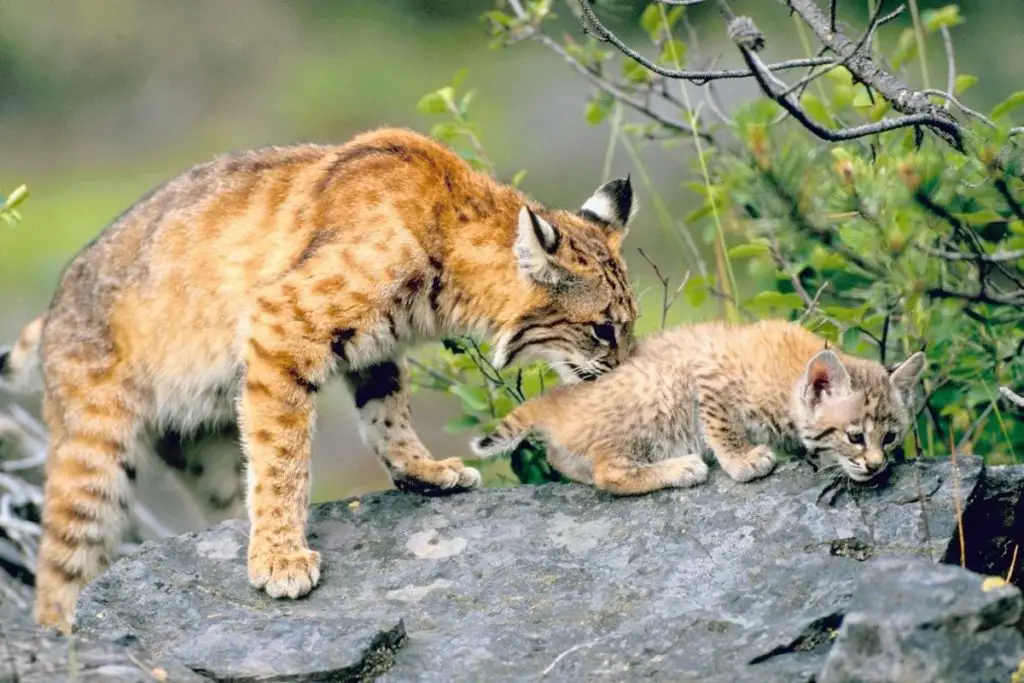
10 Bobcat Facts
1. Male bobcats are called Toms and females are called Queens. Bobcats are solitary animals and the male bobcats and female bobcats sleep in separate dens. They are not monogamous and will mate with multiple partners.
See our article for Bobcat Sleeping Habits
2. Bobcats are the smallest of the Lynx species. Out of the three main types of Lynx cats, bobcats are the smallest. They are smaller than the Canadian Lynx, and the Eurasian Lynx species.
3. Bobcats have tufts on their ears. Just like other Lynx cats, bobcats have black tufts on the top of their ears. They are not as large or pronounced ad other Lynx cats. If you see a cat in the wild with ear tufts, consider them dangerous.
4. Unlike most cats, bobcats are good swimmers. Bobcats have been known to be excellent swimmers. They will swim in rare situations and have no problem moving through the water.
5. Bobcat kittens can be confused with domestic kittens. In some cases, bob kittens have been confused with feral kittens. Just because you find kittens in the woods, doesn’t mean you should try to take them home.
See our article for Bobcat Kittens
6. Bobcats have multiple dens. One is their main den, and the others are dens that are located along their hunting routes. This allows them to hunt throughout the night, resting and taking catnaps in dens as they hunt.
7. Bobcats used to be completely nocturnal. Bobcats have night vision, this is a sign that they were completely nocturnal at one time. Now, they have adapted to crepuscular behavior by hunting at twilight, and in the day.
See our article for Are Bobcats Nocturnal?
8. You can find bobcats as far south as Mexico. Despite them most likely originating in the northern territories, these cats have been able to thrive and move into multiple regions such as the southern US, and Mexico.
9. Bobcats are surplus killers. This means that bobcats will hunt and kill more than they can eat in one sitting, and hide it close to their den, or inside of their den as a food cache for later.
10. Bobcats have a “ruff” of fur on both sides of their faces. One of the things that make a bobcat very recognizable is the ruff of fur on the sides of its face. The ruffs are very long and pronounced, making them look regal, almost like a small lion.
Black Bobcat | Melanism in Bobcats
There have been reports of people seeing black bobcats. Bobcats naturally have some black banding and spots. But some bobcats have more black fur than usual and can be partially melanistic, and in very rare cases completely black.
Melanism and Bobcats
Black bobcats have a gene mutation called melanism. Many animals in nature and even humans have this condition. In some species of animals, it is not so rare, however, with bobcats it is very rare to see a completely black bobcat.
How Rare is a Black Bobcat?
It has been speculated that less than 20 black bobcats have been caught, killed, or observed in the wild. Evidence can be seen in videos online, where people have footage of this elusive creature. Source.
Melanism is the Opposite of Albinism
Melanism can be seen as the opposite of being Albino. Albino bobcats are just as rare as melanistic black bobcats. They appear to be almost completely white because of their lack of melanin. Both of these rare cats would be a sight to behold in the wild.
Where Are Black Bobcats Found?
Black bobcats can be found across North America. They have been spotted in California, Virginia, Alabama, and other states. Because melanism is a genetic mutation, any bobcat, anywhere, could have melanism.
How to Tell if Your Cat is Mixed With Bobcat
There are stories about bobcats, and domestic cats, as hybrids. However, no hybrid bobcats have ever been found and studied to suggest that they exist. Most cats that get mistaken for a bobcat hybrid, are breeds that look similar to bobcats.
You could tell if your cat is mixed with a bobcat by examining them. If they have a short tail, around five inches, banding or spots, then you may have a bobcat. Or it could be a similar-looking domestic cat breed, such as a Maine coon.
Can a Bobcat Mate With a Domestic Cat?
The answer to this is tricky. There have been many instances where people have reported bobcat and domestic cat hybrids. There are also many photos online you can find of these seemingly rare instances. While science doesn’t suggest that bobcat hybrids are viable, weirder things have happened.
Learn more about Bobcat Mating Season
If a bobcat hybrid did exist, it would not be able to produce offspring due to being infertile. This is true for most hybrids in the animal world. So even if your cat was a bobcat hybrid, there would be no chance of creating a hybrid breed capable of producing a lineage.
Bobcat Symbolism
Animals have been used as symbols for as long as symbols have been used. Bobcat symbolism is indicative of the traits that bobcats possess. Such as beauty, affection, confidence, and being stealthy. Humans have used zootype symbolism to represent a multitude of spiritual meanings such as animal spirit guides, power spirits, and more.
Is Seeing a Bobcat a Good Omen?
Bobcat symbolism means something different to everyone. Among Native Americans, some tribes thought of the bobcat as lucky while others thought of it as a negative omen.
If the bobcat is your spirit animal and totem power animal, then seeing the bobcat, to me is a sign that you are in the right place at the right time. However, if you do see a bobcat in the wild, you should not approach it. Observe, and move on.
Bobcat Mythology
Bobcat mythology among the Native Americans can be found in many tribes, who pair the bobcat with the coyote, both representing different elemental forces. The duality of the two can be found in many of their stories.
Because bobcats are unique to North America, their symbolism, mythology, and stories exist in many parts of the continent. Many of the attributes that bobcats utilize can be found in the attitude and energy of bobcat symbolism. They are hunters, stealthy, brutal, quick, and precise.
You can apply these attributes spiritually to your own spiritual advancement and studies. Take what you have learned here, and meditate on them, visualize yourself with that energy. If you connect with bobcats on a spiritual level, let them guide you, and take them seriously when they speak to you.
Bobcat Symbolism in Dreams
Symbolism and dreams go together so well because the subconscious mind operates with, and understands, the language of symbolism. What is veiled to us in our waking hours, can be lifted in our dreams, so that we may get a glimpse of something that is reaching out to us.
Bobcat symbolism in dreams can mean many things such as being betrayed, being alerted to something wrong, and on the flip side, that something powerful is coming your way. It is up to you to interpret what these bobcat symbols in dreams mean to you.
By analyzing our dreams we can lift the veil a little, and look a little deeper into our feelings and what is bothering us on the inside. If you have a bobcat spirit guide, listen closely to what they have to tell you in your dreams. Once you have made that connection with them, they are there to help guide you.
Will a Bobcat Attack a Dog
Bobcats are wild animals that prey on small animals. This means that if a wild bobcat were to come across a small dog or pet, the pets would probably be in danger. Wild animals are unpredictable, and even if they look cute, or interesting, do not approach them, and get your pets to safety.
Because bobcats are territorial, they may see your dog as a threat and could attack them. Chances are if your dog is big enough, a bobcat is just going to watch them at a distance until they can maneuver around them to find prey that is easier to kill, such as squirrels, and small game.
See our article for Are Bobcats Dangerous?

What to Do If You See a Bobcat
Chances are you will never see a bobcat in the wild. We get to observe these majestic animals in sanctuaries, that help rescue cats that are injured, misplaced by their mother, or needing special attention.
If you see a bobcat in the wild, you should not get close to it. Bobcats can be dangerous and if they see you as a threat, you could be put into a bad situation. You need to move away from the area, as quietly as you can and get to a safe location, like inside of a vehicle.
For more information see Bobcat Habitats
If you think you have come upon a litter of bobcat kittens in the wild, be especially careful. Bobcat mothers are very protective of their young and if the mother is around you will be in danger.
Bobcats have to leave their kittens for long periods, to hunt, feed the kittens, and make sure they and their kittens have the best chance at survival. In most cases, kittens will not be abandoned but will be waiting for their mother to return.
If you think you absolutely have determined that the kittens are abandoned, do not approach them or touch them. They can bite, scratch, and worse. You would need to get to a safe area and call someone who can handle wild animals and that have a history with bobcats.
How to Scare a Bobcat
Many experts say that if you think a bobcat is nearby or has been coming around your yard, the best thing you can do is yell loudly at it. Bobcats are solitary and do not like human activity in the first place, and yelling at them will be a way for you to tell them they are not welcome.
This technique is used on some types of bears, in the wild. When being stalked by a bear, in some situations you should yell very loudly HEY BEAR. This will alarm animals, such as bears and bobcats, allowing them to move on, and away from you. Learning how to scare a bobcat can be an effective way to keep them away from you and your property.
Bobcat Characteristics
Bobcat characteristics include several physical traits as well as behaviors that they exhibit. They behave in ways that are similar to other wild animals but also have a few traits that make them different.
Bobcats communicate in many unique ways. The fur stands up on their backs when they feel threatened, and they will also stand sideways and hiss. They have several calls and noises that they use to warn others, call out to others, cry out for food, and more.
See our article for Bobcat Sounds
Other bobcat characteristics include their ability to adapt. They have managed to survive in many different places, regions, and environments. Even with thick fur, they can survive in warm areas in the southern parts of the continent.
Take a look at our article Bobcat Adaptations
Bobcat fur can be many different colors, such as orange, white, tan, black, gold, brown, red, and more.
See examples in our article Bobcat Colors
Bobcat claws are retractable and this benefits them in many ways. They can clinch the terrain as they move across forest beds, boulders, and cliffs when they need to. It can also allow them to pounce around without damaging their claws. They are even known to sometimes climb trees.
See our article for Can Bobcats Climb Trees
Bobcats are best known for their sly, stealthy, and elusive characteristics. These qualities have helped them survive for almost 2 million years. They have had a close connection with native peoples, and have lived around and among humans since the beginnings of our recorded history.
Is a Bobcat a Carnivore?
Yes, bobcats are carnivores. The bobcat’s diet consists mostly of prey animals. They can prey on anything from squirrels, birds, rodents, and even small deer can be food for a bobcat.
See our article for What Do Bobcats Eat
In times when food is scarce, fewer kittens will survive and many sacrifices have to be made to make sure the mother and at least some of the kittens survive. Many times in nature we see that the food source can directly affect the population of a species. If there is less food where a bobcat lives, fewer babies are born, and even fewer survive.
See our article for Where Do Bobcats Live
There’s no doubt that these amazing cats have made their mark in the world. Even though they are one of the smallest, big cats, they hold their own and continue to adapt and survive.
Can Bobcats Be Pets?
Bobcats do not make good pets. However, people sometimes rescue bobcats, rehabilitate them, and care for them. They do sometimes get raised as pets, and they even get sold as exotic pets in some instances.
See our article for Bobcats as Pets
Now that you know a few things about bobcats, let’s take a look at some questions that get asked pretty often.
All Bobcat Articles
Where Do Bobcats Sleep?
Bobcat Vs Lynx | Know The Difference
Baby Bobcats | What Are Baby Bobcats Called?
Bobcat Tails | Do Bobcats Have Tails?
Bobcat Colors | What Colors are Bobcats?
Bobcat Size and Appearance
How Long Do Bobcats Live | Bobcat Lifespan
Bobcat Adaptations
Types of Bobcats | List of Bobcat Species
Bobcats As Pets | Can You Have a Pet Bobcat
Bobcat Dens | The Ultimate Guide
Can Bobcats Climb Trees?
Bobcat vs Mountain Lion (w. Video)
Bobcat Sounds | What Does A Bobcat Sound Like? (w. Audio and Video)
Bobcats Mating Season
What Do Bobcats Look Like? The Complete Guide
What Do Bobcats Eat? The Ultimate Guide
Are Bobcats Nocturnal?
Bobcat Habitat
Where Do Bobcats Live?
Are Bobcats Dangerous?
Frequently Asked Questions
Bobcats are “big cats” from the Lynx family. They are related to the Canadian Lynx and the Eurasian Lynx species. Although they are considered a big cat species, they are smaller than their Lynx relatives.
Bobcats do not eat cats. They may be forced to fight a cat over territory and in rare cases, they may eat a cat if they are suffering from starvation. However, you should still bring your cats inside if you think there is a chance that a bobcat could be in the area.
Yes, a bobcat can kill you. They are unpredictable and equipped with enough muscle, claws, and power, to do serious harm to you. You should never try to approach a wild bobcat. If you must, observe them from a distance, and get to safety.
Bobcats can be found throughout many parts of Florida. They prefer flatlands and open fields to hunt in and Florida has many of those optimal types of hunting grounds. They have access to many types of food sources, such as squirrels, rodents, eggs, birds, and more.
Have you seen a bobcat? Tell us about it in the comments below!



